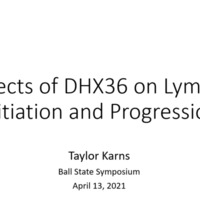Browse Exhibits (1 total)
Taylor Karns | The Effects of DHX36 on Lymphoma Initiation and Progression

Cancer kills nearly 700 thousand people each year in the United States, making the discovery of novel therapeutic targets an urgent need. The c-MYC gene is a cancer-driving gene that is commonly found to be overabundant in tumors. Relevant to the research in our lab, the c-MYC gene promoter sequence is highly enriched with guanines (G’s). G-rich DNA or RNA sequences can form “knot-like” structures termed G-quadruplexes that act as regulatory checkpoints for transcription. For transcription to proceed, the G-quadruplex must be untied. The cell contains enzymes that unwind G-quadruplexes. The major enzyme responsible for untying G-quadruplexes is Dhx36. Dhx36 is overabundant in most cancers and increases c-MYC expression. For this study, I will determine if overexpression of Dhx36 initiates tumorigenesis and/or increases the progression of established tumors. I hypothesize that Dhx36 overexpression will initiate tumorigenesis and accelerate tumor growth. I will test this hypothesis using novel transgenic mouse tumor models. c-MYC expression levels will be assessed using qRT-PCR and RNA sequencing technologies. I expect completion of this work will contribute to the basic understanding of cancer pathogenesis and begin to establish Dhx36 as a novel therapeutic target.
Credits: Taylor Karns, Tyler Osborne, Michael Reisinger, Siara Sandwith, Philip Smaldino Ph.D.
Faculty Mentor: Dr. Phil Smaldino
Department of Biology
Graduate
